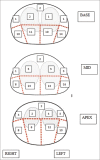Multiparametric magnetic resonance imaging-transrectal ultrasound fusion prostate biopsy: A prospective, single centre study
- PMID: 28469301
- PMCID: PMC5396401
- DOI: 10.4103/0970-1591.203414
Multiparametric magnetic resonance imaging-transrectal ultrasound fusion prostate biopsy: A prospective, single centre study
Abstract
Introduction: Transrectal rectal ultrasound (TRUS)-guided systematic biopsy is the gold standard for diagnosis of prostate cancer. However, systematic biopsy has high false-negative rate and often misses anteriorly located tumors. Magnetic resonance imaging (MRI)-TRUS fusion biopsy can potentially improve cancer detection by better visualization and targeting of cancer focus. We evaluated the role of fusion biopsy in detection of prostate cancer and the association of prostate imaging reporting and data system (PI-RADS) score for predicting cancer risk and its aggression.
Methods: Ninety-six consecutive men with suspected prostate cancer underwent MRI-TRUS fusion-targeted biopsy of suspicious lesions and standard 12 core biopsy from May 2014 to July 2015 in our institution. All patients underwent 3.0 T multiparametric MRI before biopsy. mp-MRI included T2W, DWI, DCE and MRS sequences to identify lesions suspicious for prostate cancer. Suspected lesions were scored according to PI-RADS scoring system. Comparison of cancer detection between standard 12 core biopsy and MRI-TRUS fusion biopsy was done. Detection of prostate cancer was primary end point of this study.
Results: Mean age was 64.4 years and median prostate-specific antigen was 8.6 ng/ml. Prostate cancer was detected in 57 patients (59.3%). Of these 57 patients, 8 patients (14%) were detected by standard 12 core biopsy only, 7 patients (12.3%) with MRI-TRUS fusion biopsy only, and 42 patients (73.7%) by both techniques. Of the 7 patients, detected with MRI-TRUS fusion biopsy alone, 6 patients (85.7%) had Gleason ≥7 disease. Prostate cancer was detected on either standard 12 core biopsy or MRI-TRUS fusion biopsy in 0%, 42.8%, 74%, and 89.3% patients of suspicious lesions of highest PI-RADS score 2, 3, 4, and 5, respectively.
Conclusions: MRI-TRUS fusion prostate biopsy improves cancer detection rate when combined with standard 12 cores biopsy and detects more intermediate or high-grade prostate cancer (Gleason ≥7). With increasing PI-RADS score, there is an increase chance of detection of cancer as well as its aggressiveness.
Conflict of interest statement
Conflicts of interest: There are no conflicts of interest.
Figures
Similar articles
-
Early experience with multiparametric magnetic resonance imaging-targeted biopsies under visual transrectal ultrasound guidance in patients suspicious for prostate cancer undergoing repeated biopsy.Scand J Urol. 2015 Feb;49(1):25-34. doi: 10.3109/21681805.2014.925497. Epub 2014 Jun 12. Scand J Urol. 2015. PMID: 24922550
-
Comparison of prostate cancer detection rates between magnetic resonance imaging-targeted biopsy and transrectal ultrasound-guided biopsy according to Prostate Imaging Reporting and Data System in patients with PSA ≥4 ng/mL: a systematic review and meta-analysis.Transl Androl Urol. 2019 Dec;8(6):741-753. doi: 10.21037/tau.2019.12.03. Transl Androl Urol. 2019. PMID: 32038971 Free PMC article.
-
[Real-time MRI/US fusion-guided biopsy improves detection rates of prostate cancer in pre-biopsied patients].Aktuelle Urol. 2014 May;45(3):197-203. doi: 10.1055/s-0034-1375682. Epub 2014 Jun 5. Aktuelle Urol. 2014. PMID: 24902069 German.
-
Multiparametric MRI in detection and staging of prostate cancer.Dan Med J. 2017 Feb;64(2):B5327. Dan Med J. 2017. PMID: 28157066 Review.
-
Multiparametric MRI and targeted prostate biopsy: Improvements in cancer detection, localization, and risk assessment.Cent European J Urol. 2016;69(1):9-18. doi: 10.5173/ceju.2016.734. Epub 2016 Jan 25. Cent European J Urol. 2016. PMID: 27123316 Free PMC article. Review.
Cited by
-
Magnetic resonance imaging-ultrasound fusion-targeted biopsy combined with systematic 12-core ultrasound-guided biopsy improves the detection of clinically significant prostate cancer: Are we ready to abandon the systematic approach?Urol Ann. 2020 Oct-Dec;12(4):366-372. doi: 10.4103/UA.UA_123_19. Epub 2020 Oct 15. Urol Ann. 2020. PMID: 33776334 Free PMC article.
-
Robust and efficient pharmacokinetic parameter non-linear least squares estimation for dynamic contrast enhanced MRI of the prostate.Magn Reson Imaging. 2018 May;48:50-61. doi: 10.1016/j.mri.2017.12.021. Epub 2017 Dec 24. Magn Reson Imaging. 2018. PMID: 29278764 Free PMC article.
-
Prostate cancer detection using magnetic resonance imaging-transrectal ultrasound fusion biopsy: A retrospective cohort study.Indian J Urol. 2023 Oct-Dec;39(4):297-302. doi: 10.4103/iju.iju_147_23. Epub 2023 Sep 29. Indian J Urol. 2023. PMID: 38077193 Free PMC article.
-
3.0 T MRI IVIM-DWI for predicting the efficacy of neoadjuvant chemoradiation for locally advanced rectal cancer.Abdom Radiol (NY). 2021 Jan;46(1):134-143. doi: 10.1007/s00261-020-02594-4. Abdom Radiol (NY). 2021. PMID: 32462386 Free PMC article.
-
Multiparametric magnetic resonance imaging-transrectal ultrasound fusion biopsies increase the rate of cancer detection in populations with a low incidence of prostate cancer.Investig Clin Urol. 2019 May;60(3):156-161. doi: 10.4111/icu.2019.60.3.156. Epub 2019 Apr 12. Investig Clin Urol. 2019. PMID: 31098422 Free PMC article.
References
-
- Siegel R, Ma J, Zou Z, Jemal A. Cancer statistics, 2014. CA Cancer J Clin. 2014;64:9–29. - PubMed
-
- Yeole BB. Trends in the prostate cancer incidence in India. Asian Pac J Cancer Prev. 2008;9:141–4. - PubMed
-
- Yacoub JH, Verma S, Moulton JS, Eggener S, Aytekin O. Imaging-guided prostate biopsy: Conventional and emerging techniques. Radiographics. 2012;32:819–37. - PubMed
-
- Lawrentschuk N, Haider MA, Daljeet N, Evans A, Toi A, Finelli A, et al. 'Prostatic evasive anterior tumours': The role of magnetic resonance imaging. BJU Int. 2010;105:1231–6. - PubMed
-
- Yakar D, Hambrock T, Hoeks C, Barentsz JO, Fütterer JJ. Magnetic resonance-guided biopsy of the prostate: Feasibility, technique, and clinical applications. Top Magn Reson Imaging. 2008;19:291–5. - PubMed
LinkOut - more resources
Full Text Sources
Other Literature Sources
Research Materials
Miscellaneous


